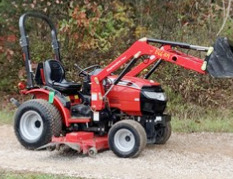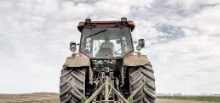________________________________________________________________________________________
| Home / Farm Tractors / Mahindra Tractors / Mahindra Max 22 |
Mahindra Max 22 Troubleshooting
 The
Mahindra Max 22 sub-compact utility tractor was manufactured between 2012 and
2014. The Mahindra Max 22 driveline consists of Mitsubishi S3L 4-cycle
3-cylinder vertical overhead valve indirect injection liquid-cooled diesel
engine and 2-range hydrostatic transmission. A 68.8 cubic inches (1.1 L) engine
has a cylinder bore of 3.07" (78 mm), piston stroke of 3.09" (78.5 mm), and
rated power of 22 Hp (16.4 kW). The maximum forward speed - 9.6 mph (15.5 km/h),
maximum reverse speed - 5 mph (8 km/h).
The
Mahindra Max 22 sub-compact utility tractor was manufactured between 2012 and
2014. The Mahindra Max 22 driveline consists of Mitsubishi S3L 4-cycle
3-cylinder vertical overhead valve indirect injection liquid-cooled diesel
engine and 2-range hydrostatic transmission. A 68.8 cubic inches (1.1 L) engine
has a cylinder bore of 3.07" (78 mm), piston stroke of 3.09" (78.5 mm), and
rated power of 22 Hp (16.4 kW). The maximum forward speed - 9.6 mph (15.5 km/h),
maximum reverse speed - 5 mph (8 km/h).
The open center hydraulic system includes a gear pump with rated fluid flow of 4.6 gpm (17.5 lpm). The Mahindra Max 22 is equipped with a hydrostatic power steering system, hydraulic wet disc brakes, 6.00x12 (AG) or 20x8.00-10 (Turf) front tyres, and 9.50x16 (AG) or 27x12.5-15 (Turf) rear tyres. The tractor is compatible with a 56" front-mount two-stage Mahindra MXSB-56 snowblower, 62" front blade Mahindra MXBL-62, Mahindra ML202 front end-loader with a maximum lift height of 75" (1900 mm), and Mahindra MB60A backhoe with maximum digging depth of 80" (2030 mm).
| Engine Troubleshooting |
| Engine starts up hard or will not start |
Air in the fuel system - Air bleeding.
Dirty fuel filter - Replace the filter element.
Clogged or defective injection nozzles - Check and replace nozzles if required.
Water or dirt in fuel system - Drain, flush, and service the system.
Incorrect valve clearance - Adjust valve clearance.
Fuel injection pump is not working correctly - Rebuild or change fuel pump.
| Engine starts but immediately stalls |
Air cleaner is dirty - Clean or change.
Fuel filter element clogging - Clean or replace the filter.
Problems with fuel injection pump tightness - Inspect fuel injection pump for leaks.
Fuel injectors are faulty or clogged - Replace or clean fuel injectors.
Fuel injection pump is damaged - Change pump or rebuild it.
| Engine stops suddenly during operation |
Engine is cold - Engine is not warmed up to the required temperature.
Fuel filter element is dirty - Replace the filter element.
Air in the fuel system - Air bleeding.
Faulty fuel injection nozzles - Clean or replace injection nozzles.
Improper fuel injection timing - Adjust fuel injection pump as required.
| Engine stops at low idle speed |
Incorrect low idle setting - Need to adjust idle speed.
Fuel injection pump is defective - Change pump or rebuild it.
Dirty or defective injectors - Inspect fuel injectors and change as required.
The valve clearance is not adjusted - Adjustment procedure required.
| Diesel engine is losing power |
Air filter is dirty - Service air cleaner.
Faulty fuel injection nozzles - Clean or replace injection nozzles.
Incorrect fuel injection pressure - Adjust to proper pressure.
The valve clearance is not adjusted - Adjust to proper valve clearance.
Incorrectly set low idle speed - Correct the settings.
Restricted fuel lines or hoses - Service fuel lines and hoses.
Defective cylinder head gasket - Install a new gasket.
Leaking or damaged piston rings - Replace piston rings.
| Engine is overheated |
Engine coolant is insufficient - Fill radiator to proper level and check components for faults.
Lack of engine oil - Fill the crankcase with engine oil.
Faulty radiator cap or dirty radiator fins - Clean radiator or change cap.
Excessive wear of the fan belt - Replace the fan belt.
Engine is overloaded - Load reducing is recommended.
| Oil pressure too low |
Engine oil level low - Add oil as required.
Oil filter element is dirty - Change or clean engine oil filter element.
Incorrect oil viscosity - Use oil of proper viscosity.
Crankshaft bearing oil clearance is excessive - Bearings need to be reinstalled.
Oil pump malfunction - Install a new pump.
| Engine noise or knocking |
Engine oil level is low - Fill up the oil to required level.
Engine not warmed up - Normalize the temperature by warming up the engine.
Improper fuel injection timing - Adjust the pump as required.
Low idle speed setting is not correct - Adjust low idle speed.
Defective fuel injectors - Test and replace fuel injectors if necessary.
Misaligned or defective connecting rod Alignment procedure or replacement is required.
Pistons are worn or scored - Install new pistons.
| Hydrostatic Transmission Troubleshooting |
| Excessive hydrostatic transmission noise |
Low transmission oil level or contaminated oil - Add oil to the correct level or fill the transmission with fresh oil.
Speed control linkage is defective or unadjusted - Adjust or replace linkage.
Stuck relief valve - Install a new valve.
Transmission overload - Reduce transmission load.
Worn or defective transmission components - Replace or repair defective components.
| Lack of power |
Low fluid level - Checking transmission fluid level and add if necessary.
Relief valve failure - Change the valve.
Worn or unadjusted speed control linkage - Repair or adjust linkage.
| Transmission oil overheated |
Lack of transmission oil supply - Check and refill the transmission oil.
Transmission oil filter is clogged - Clean or change transmission oil filter.
Defective or plugged cooling components - Inspect all cooling components and replace or clean if necessary.
Excessive transmission load - Reduce the load is required.
| Transmission fluid leaks |
Seals or gaskets are worn - Gaskets or seal replacement required.
Internal transmission housing pressure is too high - Change defective parts.
Clogged oil drain line - Clean or replace drain line.
| Hydraulic System Troubleshooting |
| Low hydraulic system pressure |
Hydraulic oil is insufficient - Checking hydraulic oil level and add if necessary.
Dirty hydraulic fluid filter element - Install a new hydraulic filter element.
Defective hydraulic pump - Install a new hydraulic fluid pump.
Hydraulic control valve block is set improperly - Set properly.
Hydraulic cylinder is defective - Replace or repair hydraulic cylinder.
Leaks in hydraulic lines - Inspect the system for leaks and fix it.
| Hydraulic system overheated |
Damaged main relief valve - Relief valve must be changed.
Incorrect hydraulic oil type - Use the correct type of hydraulic oil.
Hydraulic oil contamination - Change the oil.
Air in hydraulic pipes - Bleed hydraulic pipes.
| 3-point hitch cannot be raised or raising is too slowly |
Heavy load on the hitch - Reduce loading.
Hydraulic fluid is insufficient - Add fluid as required.
Hydraulic oil filter element is clogged - Clean or replace the hydraulic filter.
Hydraulic pump is faulty - Change or repair hydraulic oil pump.
Defective main relief valve - Relief valve replacement required.
Hydraulic control valve block is damaged - Replace or repair the valve.
Hydraulic cylinder not working - Change or repair hydraulic cylinder.
Suction pipe is disconnected or broken - Connect or replace pipe.
| Hitch not lowering or hitch lowers slowly |
Incorrect setting hydraulic control valve block - Set correctly.
Faulty hydraulic cylinder - Install a new hydraulic cylinder or repair it.
Misadjusted hitch - Adjust three-point hitch as required.
Worn hitch rock shaft - Install a new shaft.
| Hitch lift or drop is jerky |
Air in the hydraulic system - Air bleeding.
Hydraulic oil contamination - Change the oil.
Hydraulic pump not working - Change or repair hydraulic fluid pump.
Hydraulic control valve is faulty - Change or repair hydraulic valve.
Hydraulic cylinder is broken - Change or repair hydraulic cylinder.
| Steering System Troubleshooting |
| Steering is hard |
Improperly mounted or worn steering column - Mount the steering column as required or change it.
Air in steering hydraulic system - Bleed air.
Incorrect toe-in - Adjust toe-in wheels.
Tires have uneven wear - Replace the tires.
Steering pump failure - Check the steering pump and replace if necessary.
Steering pump control valve is faulty or stuck - Clean or install new control valve.
Steering fluid level is insufficient - Add oil to steering system.
| Excessive free play of steering wheel |
Steering column coupling or shaft is extremely worn out - Change defective part.
Steering pump not working - Replace or repair steering pump.
Worn or loose steering linkage joints - Repair or replace steering linkage.
| Tractor is pulling to left or right |
Front tires are worn unevenly - Install new tires.
Incorrect toe-in - Check and adjust toe-in.
Steering linkage joints are worn or loose - Inspect and replace as required.
Defective or improperly adjusted front wheel bearings - Change or adjust bearings correctly.
| Electrical System Troubleshooting |
| Battery cannot be charged |
Loose or corroded cable connections - Tighten or service connections.
Battery terminal clamps are faulty - Terminal clamps should be changed.
Battery failing - Battery replacement required.
Worn or loose belt - Adjust belt tension or change the belt.
| Starter turns slowly |
Battery capacity is low - Battery is drained, recharge it.
Battery does not hold charge - Service battery or replace it.
Corroded battery terminals or disconnected wires - Check cables and clean or change terminals.
| Starter motor won't turn |
Battery is low or faulty - Replace or charge as required.
Wiring harness is disconnected or improperly connected - Check wiring harness and connect as required.
Low battery output voltage - Charge the battery.
Starter motor is defective - Repair or change starter.
________________________________________________________________________________________
________________________________________________________________________________________
| Farm Tractors Technical Specifications |
